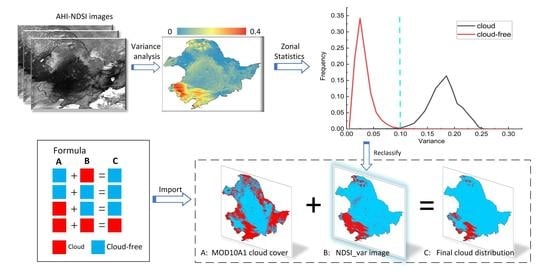Cloud–Snow Confusion with MODIS Snow Products in Boreal Forest Regions
Abstract
:1. Introduction
2. Study Area and Data
2.1. Study Area
2.2. MODIS/Terra Snow Cover Product MOD10A1 C6
2.3. MODIS Surface Reflectance Product MOD09GA
2.4. Advanced Himawari Imager (AHI) Data
2.5. Gridded Climatic Research Unit Time-Series Data
3. Cloud–Snow Confusion in MOD10A1
3.1. Cloud Mask in MOD10A1
3.2. Clouds Misclassified as Snow
4. Cloud–Snow Identification Methods
- The NDSI of each pixel in the 25 AHI images was calculated from 8:30 to 12:30; before that, band2 and band 5 had to be resampled to 500m in order match to MODIS.
- The NDSI variance in the AHI images was calculated, and the NDSI variance images were named NDSI_var.
- For the pixel in NDSI_Snow_Cover with a value of 250, if the corresponding value in NDSI_var was less than 0.1, it was replaced with the raw NDSI of this pixel; otherwise, it was retained as 250. After this step, the pixels that were misclassified as clouds could be restored to their raw NDSI value.
- For all the pixels in NDSI_Snow_Cover with values greater than 0 and less than 100, if the corresponding value in NDSI_var was equal to or greater than 0.1, then the pixel value was changed to 250. That is, this pixel was thought to probably be an ice cloud. The ice clouds that were misclassified as snow could be identified in this step.
5. Validation and Discussion
5.1. Validation with Example Images
5.2. Discussion
6. Conclusions
Author Contributions
Funding
Acknowledgments
Conflicts of Interest
References
- Brown, R.D.; Mote, P.W. The Response of Northern Hemisphere Snow Cover to a Changing Climate. J. Clim. 2009, 22, 2124–2145. [Google Scholar] [CrossRef]
- Hall, D.K.; Riggs, G.A. Accuracy assessment of the MODIS snow products. Hydrol. Process. 2007, 21, 1534–1547. [Google Scholar] [CrossRef]
- Barnett, T.P.; Adam, J.C.; Lettenmaier, D.P. Potential impacts of a warming climate on water availability in snow-dominated regions. Nature 2005, 438, 303–309. [Google Scholar] [CrossRef] [PubMed]
- Alessandri, A.; Catalano, F.; De Felice, M.; Hurk, B.V.D.; Balsamo, G. Varying snow and vegetation signatures of surface-albedo feedback on the Northern Hemisphere land warming. Environ. Res. Lett. 2021, 16, 10. [Google Scholar] [CrossRef]
- Thackeray, C.W.; Derksen, C.; Fletcher, C.G.; Hall, A. Snow and Climate: Feedbacks, Drivers, and Indices of Change. Curr. Clim. Change Rep. 2019, 5, 322–333. [Google Scholar] [CrossRef]
- Dozier, J.; Painter, T.H. Multispectral and hyperspectral remote sensing of alpine snow properties. Annu. Rev. Earth Planet. Sci. 2004, 32, 465–494. [Google Scholar] [CrossRef] [Green Version]
- Immerzeel, W.W.; Droogers, P.; De Jong, S.M.; Bierkens, M.F.P. Large-scale monitoring of snow cover and runoff simulation in Himalayan river basins using remote sensing. Remote Sens. Environ. 2009, 113, 40–49. [Google Scholar] [CrossRef]
- Gao, J.; Williams, M.W.; Fu, X.D.; Wang, G.Q.; Gong, T.L. Spatiotemporal distribution of snow in eastern Tibet and the response to climate change. Remote Sens. Environ. 2012, 121, 1–9. [Google Scholar] [CrossRef]
- Tang, Z.G.; Wang, J.; Li, H.Y.; Yan, L.L. Spatiotemporal changes of snow cover over the Tibetan plateau based on cloud-removed moderate resolution imaging spectroradiometer fractional snow cover product from 2001 to 2011. J. Appl. Remote Sens. 2013, 7, 14. [Google Scholar] [CrossRef]
- Zhang, G.Q.; Xie, H.J.; Yao, T.D.; Liang, T.G.; Kang, S.C. Snow cover dynamics of four lake basins over Tibetan Plateau using time series MODIS data (2001−2010). Water Resour. Res. 2012, 48, W10529. [Google Scholar] [CrossRef]
- Huang, X.D.; Deng, J.; Wang, W.; Feng, Q.S.; Liang, T.G. Impact of climate and elevation on snow cover using integrated remote sensing snow products in Tibetan Plateau. Remote Sens. Environ. 2017, 190, 274–288. [Google Scholar] [CrossRef]
- Thirel, G.; Salamon, P.; Burek, P.; Kalas, M. Assimilation of MODIS snow cover area data in a distributed hydrological model using the particle filter. Remote Sens. 2013, 5, 5825–5850. [Google Scholar] [CrossRef] [Green Version]
- Zhang, F.; Zhang, H.; Hagen, S.C.; Ye, M.; Wang, D.; Gui, D.; Zeng, C.; Tian, L.; Liu, J. Snow cover and runoff modelling in a high mountain catchment with scarce data: Effects of temperature and precipitation parameters. Hydrol. Process. 2015, 29, 52–65. [Google Scholar] [CrossRef]
- Zhang, Q.; Xiao, C.X. Cloud detection of rgb color aerial photographs by progressive refinement scheme. IEEE Trans. Geosci. Remote Sens. 2014, 52, 7264–7275. [Google Scholar] [CrossRef] [Green Version]
- An, Z.; Shi, Z. Scene learning for cloud detection on remote-sensing images. IEEE J. Sel. Top. Appl. Earth Observ. Remote Sens. 2015, 8, 4206–4222. [Google Scholar] [CrossRef]
- Xie, F.Y.; Shi, M.Y.; Shi, Z.W.; Yin, J.H.; Zhao, D.P. Multilevel cloud detection in remote sensing images based on deep learning. IEEE J. Sel. Top. Appl. Earth Observ. Remote Sens. 2017, 10, 3631–3640. [Google Scholar] [CrossRef]
- Wu, X.; Shi, Z. Utilizing multilevel features for cloud detection on satellite imagery. Remote Sens. 2018, 10, 1853. [Google Scholar] [CrossRef] [Green Version]
- Riggs, G.A.; Hall, D.K.; Román, M.O. MODIS Snow Products User Guide for Collection 6; National Snow and Ice Data Center: Boulder, CO, USA, 2016. [Google Scholar]
- Ackerman, S.; Frey, R. MODIS Atmosphere L2 Cloud Mask Product; NASA MODIS Adaptive Processing System; Goddard Space Flight Center: Greenbelt, MD, USA, 2015. [Google Scholar]
- Foga, S.; Scaramuzza, P.L.; Guo, S.; Zhu, Z.; Dilley, R.D., Jr.; Beckmann, T. Cloud detection algorithm comparison and validation for operational Landsat data products. Remote Sens. Environ. 2017, 194, 379–390. [Google Scholar] [CrossRef] [Green Version]
- Zhu, Z.; Wang, S.; Woodcock, C.E. Improvement and expansion of the Fmask algorithm: Cloud, cloud shadow, and snow detection for Landsats 4–7, 8, and Sentinel 2 images. Remote Sens. Environ. 2015, 159, 269–277. [Google Scholar] [CrossRef]
- Ben-Dor, E. A precaution regarding cirrus cloud detection from airborne imaging spectrometer data using the 1.38 um water vapor band. Remote Sens. Environ. 1994, 50, 346–350. [Google Scholar] [CrossRef]
- Hall, D.K.; Riggs, G.A.; Salomonson, V.V. Development of Methods for Mapping Global Snow Cover Using Moderate Resolution Imaging Spectroradiometer Data. Remote Sens. Environ. 1995, 54, 127–140. [Google Scholar] [CrossRef]
- Stillinger, T.; Roberts Dar, A.; Collar, N.M.; Dozier, J. Cloud Masking for Landsat 8 and MODIS Terra Over Snow-Covered Terrain: Error Analysis and Spectral Similarity Between Snow and Cloud. Water Resour. Res. 2019, 55, 6169–6184. [Google Scholar] [CrossRef] [PubMed] [Green Version]
- Cao, Y.; He, Y.J.; Zeng, Y.; Luo, Q.; Gao, T. Correction methods of MODIS cloud product based on ground observation data. J. Remote Sens. 2012, 16, 325–342. [Google Scholar]
- Ma, J.J.; Wu, H.; Wang, C.; Zhang, X.; Li, Z.Q.; Wang, X.H. Multiyear satellite and surface observations of cloud fraction over China. J. Geophys. Res.-Atmos. 2014, 119, 7655–7666. [Google Scholar] [CrossRef]
- Li, P.F.; Dong, L.M.; Xiao, H.C.; Xu, M.L. A cloud image detection method based on svm vector machine. Neurocomputing 2015, 169, 34–42. [Google Scholar] [CrossRef]
- Hollstein, A.; Segl, K.; Guanter, L.; Brell, M.; Enesco, M. Ready-to-use methods for the detection of clouds, cirrus, snow, shadow, water and clear sky pixels in sentinel-2 MSI images. Remote Sens. 2016, 8, 666. [Google Scholar] [CrossRef] [Green Version]
- Zhu, Z.; Woodcock, C.E. Object-based cloud and cloud shadow detection in andsat imagery. Remote Sens. Environ. 2012, 118, 83–94. [Google Scholar] [CrossRef]
- Selkowitz, D.J.; Forster, R.R. An automated approach for mapping persistent ice and snow cover over high latitude regions. Remote Sens. 2016, 8, 16. [Google Scholar] [CrossRef] [Green Version]
- Choi, H.; Bindschadler, R. Cloud detection in Landsat imagery of ice sheets using shadow matching technique and automatic normalized difference snow index threshold value decision. Remote Sens. Environ. 2004, 91, 237–242. [Google Scholar] [CrossRef]
- Zhu, Z.; Woodcock, C.E. Automated cloud, cloud shadow, and snow detection in multitemporal Landsat data: An algorithm designed specifically for monitoring land cover change. Remote Sens. Environ. 2014, 152, 217–234. [Google Scholar] [CrossRef]
- Wang, X.Y.; Chen, S.Y.; Wang, J. An Adaptive Snow Identification Algorithm in the Forests of Northeast China. IEEE J. Sel. Top. Appl. Earth Obs. Remote Sens. 2020, 13, 5211–5222. [Google Scholar] [CrossRef]
- Wang, X.Y.; Wang, J.; Che, T.; Huang, X.D.; Hao, X.H.; Li, H.Y. Snow Cover Mapping for Complex Mountainous Forested Environments Based on a Multi-Index Technique. IEEE J. Sel. Top. Appl. Earth Obs. Remote Sens. 2018, 11, 1433–1441. [Google Scholar] [CrossRef]
- Francis, A.; Sidiropoulos, P.; Muller, J.P. CloudFCN: Accurate and robust cloud detection for satellite imagery with deep learning. Remote Sens. 2019, 11, 2312. [Google Scholar] [CrossRef] [Green Version]
- Parajka, J.; Blöschl, G. Spatio-temporal combination of MODIS images-Potential for snow cover mapping. Water Resour. Res. 2008, 44, 72–84. [Google Scholar] [CrossRef]
- Paudel, K.P.; Andersen, P. Monitoring snow cover variability in an agropastoral area in the Trans Himalayan region of Nepal using MODIS data with improved cloud removal methodology. Remote Sens. Environ. 2011, 115, 1234–1246. [Google Scholar] [CrossRef]
- Ronco, P.D.; Michele, C.D. Cloud obstruction and snow cover in Alpine areas from MODIS products. Hydrol. Earth Syst. Sci. 2014, 18, 4579–4600. [Google Scholar] [CrossRef] [Green Version]
- Gafurov, A.; Bardossy, A. Cloud removal methodology from MODIS snow cover product. Hydrol. Earth Syst. Sci. 2009, 13, 1361–1373. [Google Scholar] [CrossRef] [Green Version]
- Gao, Y.; Xie, H.; Yao, T.; Xue, C. Integrated assessment on multitemporal and multi-sensor combinations for reducing cloud obscuration of MODIS snow cover products of the Pacific Northwest USA. Remote Sens. Environ. 2010, 114, 1662–1675. [Google Scholar] [CrossRef]
- Hall, D.K.; Riggs, G.A.; Foster, J.L.; Kumar, S.V. Development and evaluation of a cloud-gap-filled MODIS daily snow-cover product. Remote Sens. Environ. 2010, 114, 496–503. [Google Scholar] [CrossRef] [Green Version]
- Gafurov, A.; Vorogushyn, S.; Farinotti, D.; Duethmann, D.; Merkushkin, A.; Merz, B. Snow-cover reconstruction methodology for mountainous regions based on historic in situ observations and recent remote sensing data. Cryosphere 2015, 9, 451–463. [Google Scholar] [CrossRef] [Green Version]
- Huang, X.D.; Deng, J.; Ma, X.F.; Wang, Y.L.; Feng, Q.S.; Hao, X.H.; Liang, T.G. Spatiotemporal dynamics of snow cover based on multisource remote sensing data in China. Cryosphere 2016, 10, 2453–2463. [Google Scholar] [CrossRef] [Green Version]
- Chen, X.N.; Long, D.; Liang, S.L.; He, L.; Zeng, C.; Hao, X.H.; Hong, Y. Developing a composite daily snow cover extent record over the Tibetan Plateau from 1981 to 2016 using multisource data. Remote Sens. Environ. 2018, 215, 284–299. [Google Scholar] [CrossRef]
- Hou, J.L.; Huang, C.L.; Zhang, Y.; Guo, J.F.; Gu, J. Gap-filling of MODIS fractional snow cover products via non-local spatio-temporal filtering based on machine learning techniques. Remote Sens. 2019, 11, 90. [Google Scholar] [CrossRef] [Green Version]
- Li, M.Y.; Zhu, X.F.; Li, N.; Pan, Y.Z. Gap-Filling of a MODIS Normalized Difference Snow Index Product Based on the Similar Pixel Selecting Algorithm: A Case Study on the Qinghai-Tibetan Plateau. Remote Sens. 2020, 12, 1077. [Google Scholar] [CrossRef] [Green Version]
- Chen, S.Y.; Wang, X.Y.; Guo, H.; Xie, P.Y.; Sirelkhatim, A.M. Spatial and Temporal Adaptive Gap-Filling Method Producing Daily Cloud-Free NDSI Time Series. IEEE J. Sel. Top. Appl. Earth Obs. Remote Sens. 2020, 13, 2251–2263. [Google Scholar] [CrossRef]
- Dozier, J.; Painter, T.H.; Rittger, K.; Frew, J.E. Time-space continuity of daily maps of fractional snow cover and albedo from MODIS. Adv. Water Resour. 2008, 31, 1515–1526. [Google Scholar] [CrossRef]
- Dong, C.Y.; Menzel, L. Producing cloud-free MODIS snow cover products with conditional probability interpolation and meteorological data. Remote Sens. Environ. 2016, 186, 439–451. [Google Scholar] [CrossRef]
- Chen, S.Y.; Wang, X.Y.; Guo, H.; Xie, P.Y.; Wang, J.; Hao, X.H. A Conditional Probability Interpolation Method Based on a Space-Time Cube for MODIS Snow Cover Products Gap Filling. Remote Sens. 2020, 12, 3577. [Google Scholar] [CrossRef]
- Li, X.; Cheng, G.D.; Jin, H.J.; Kang, E.; Che, T.; Jin, R.; Wu, L.Z.; Nan, Z.T.; Wang, J.; Shen, Y.P. Cryospheric change in China. Glob. Planet Change 2008, 62, 210–218. [Google Scholar] [CrossRef]
- Che, T.; Dai, L.Y.; Zheng, X.M.; Li, X.F.; Zhao, K. Estimation of snow depth from passive microwave brightness temperature data in forest regions of Northeast China. Remote Sens. Environ. 2016, 183, 334–349. [Google Scholar] [CrossRef]
- Klein, A.G.; Barnett, A.C. Validation of daily MODIS snow cover maps of the Upper Rio Grande River Basin for the 2000–2001 snow year. Remote Sens. Environ. 2003, 86, 162–176. [Google Scholar] [CrossRef]
- Warren, S.G. Optical properties of ice and snow. Adv. Earth Space Sci. 1982, 20, 67–89. [Google Scholar] [CrossRef] [PubMed]
- Barahona, D.; Nenes, A. Parameterizing the competition between homogeneous and heterogeneous freezing in ice cloud formation-polydisperse ice nuclei. Atmos. Chem. Phys. 2009, 9, 5933–5948. [Google Scholar] [CrossRef] [Green Version]
- Paull, D.J.; Lees, B.G.; Thompson, J.A. An Improved Liberal Cloud-Mask for Addressing Snow/Cloud Confusion with MODIS. Photogramm. Eng. Remote Sens. 2015, 81, 119–129. [Google Scholar] [CrossRef]
- Bormann, K.J.; McCabe, M.F.; Evans, J.P. Satellite based observations for seasonal snow cover detection and characterisation in Australia. Remote Sens. Environ. 2012, 123, 57–71. [Google Scholar] [CrossRef]
- Sirguey, P.; Mathieua, R.; Arnaud, Y. Subpixel monitoring of the seasonal snow cover with MODIS at 250 m spatial resolution in the Southern Alps of New Zealand: Methodology and accuracy assessment. Remote Sens. Environ. 2009, 113, 160–181. [Google Scholar] [CrossRef]
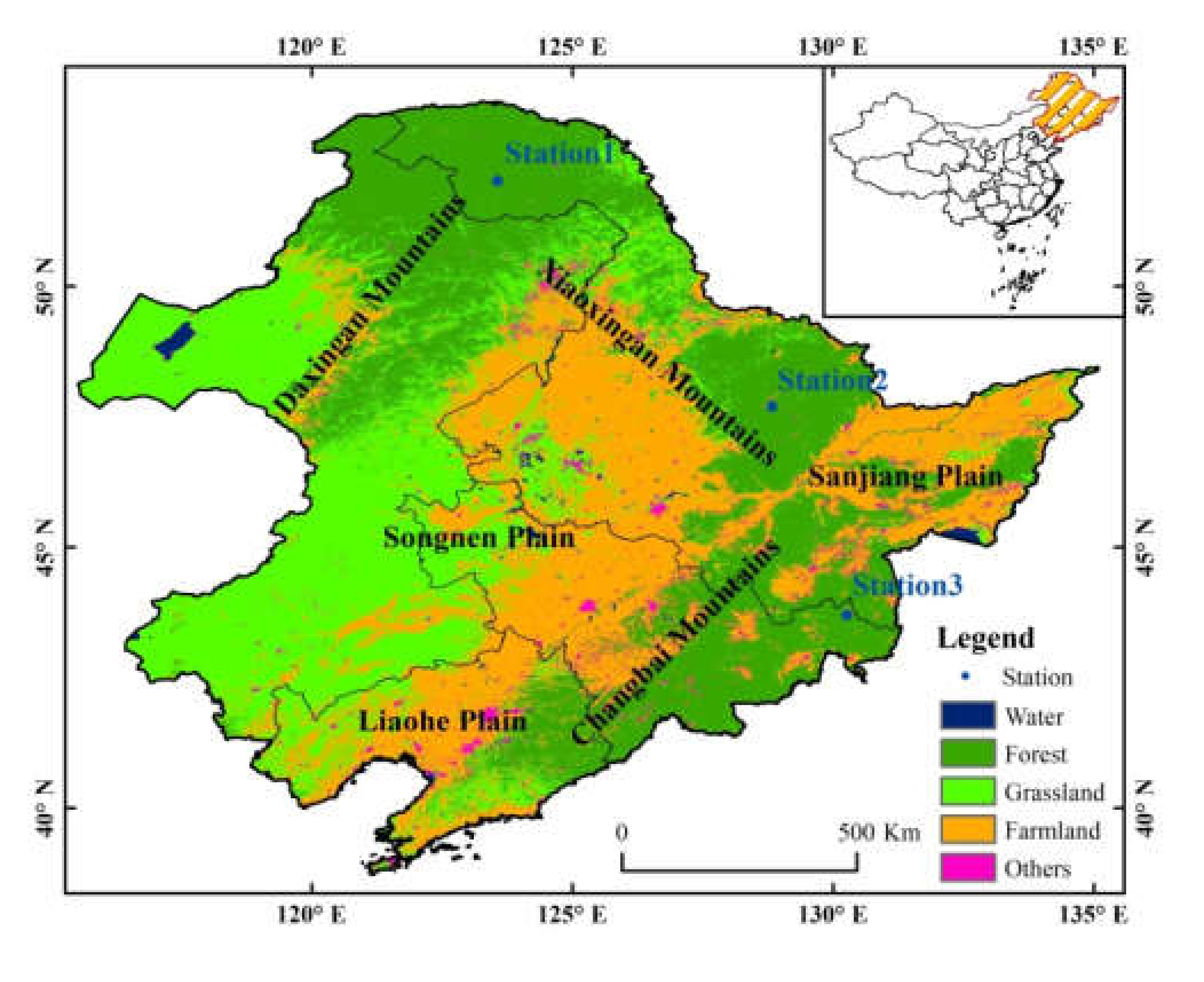
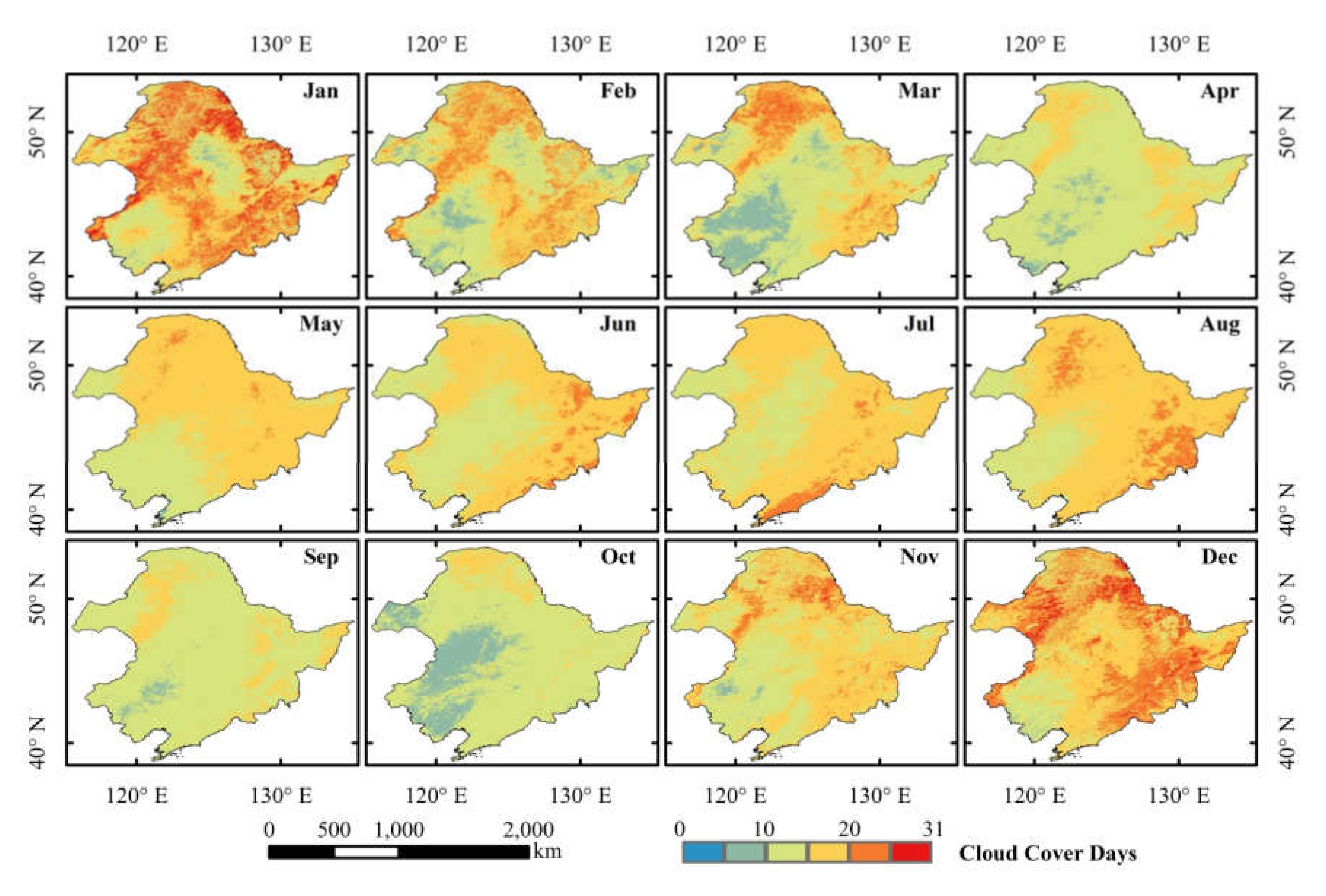
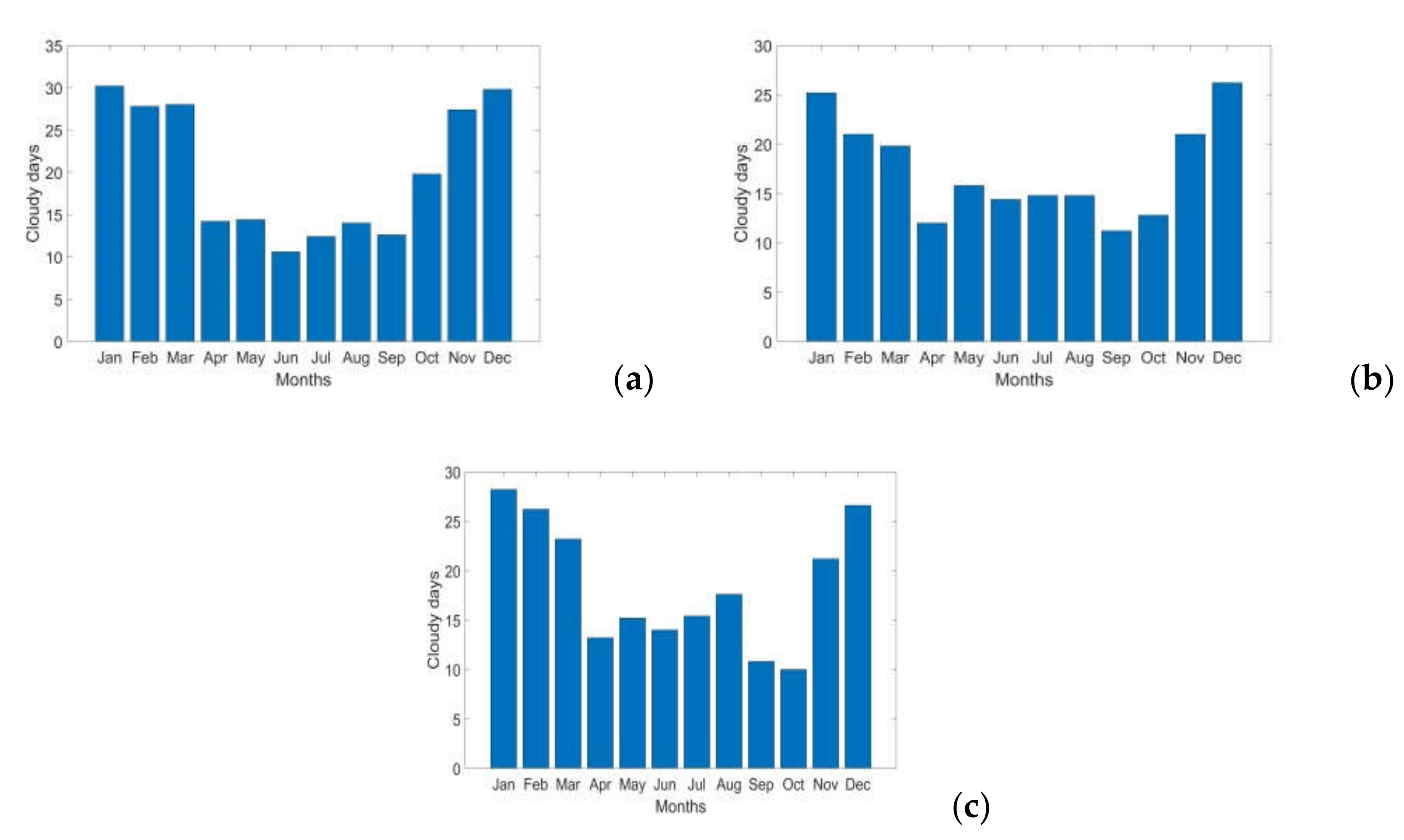

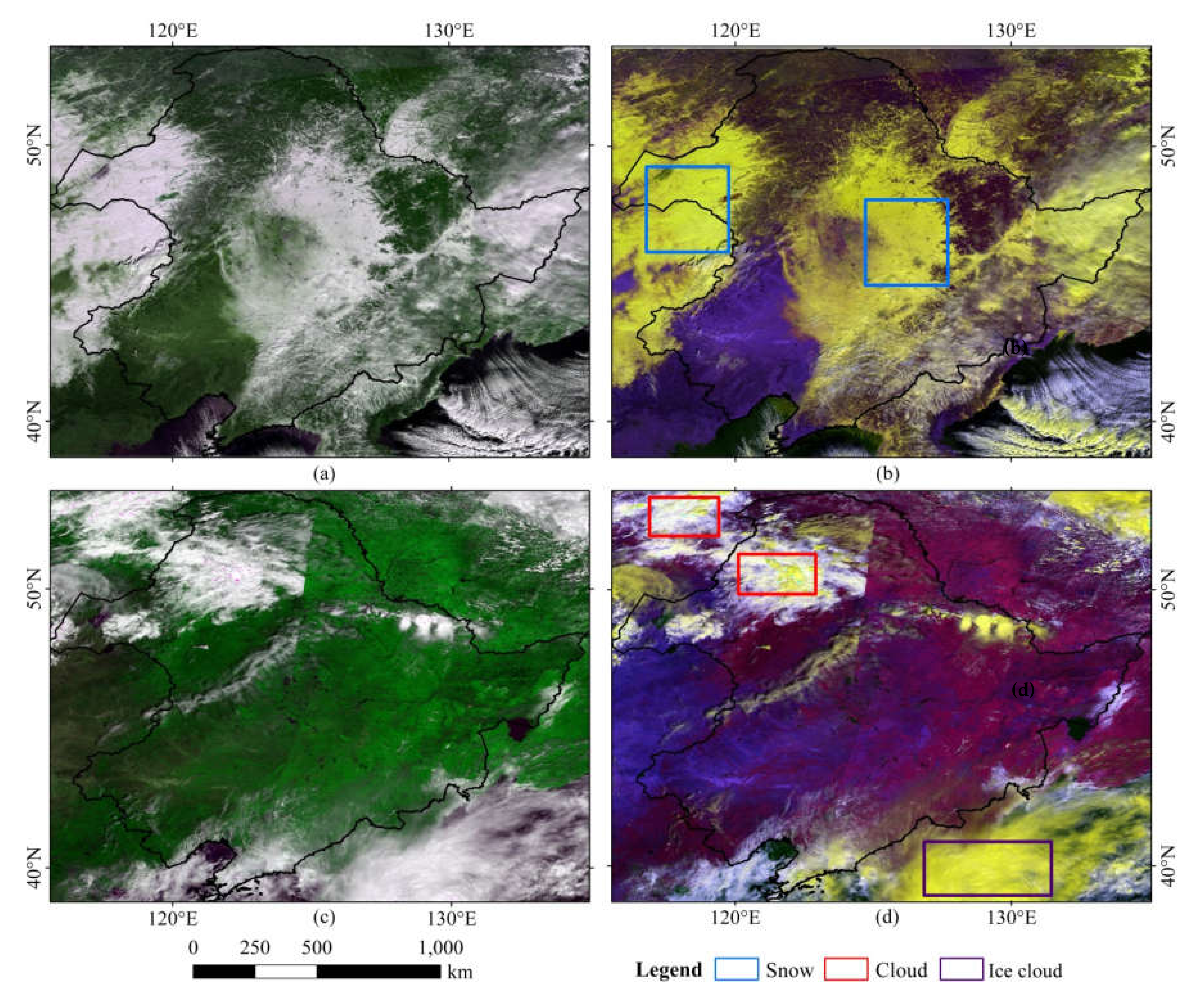
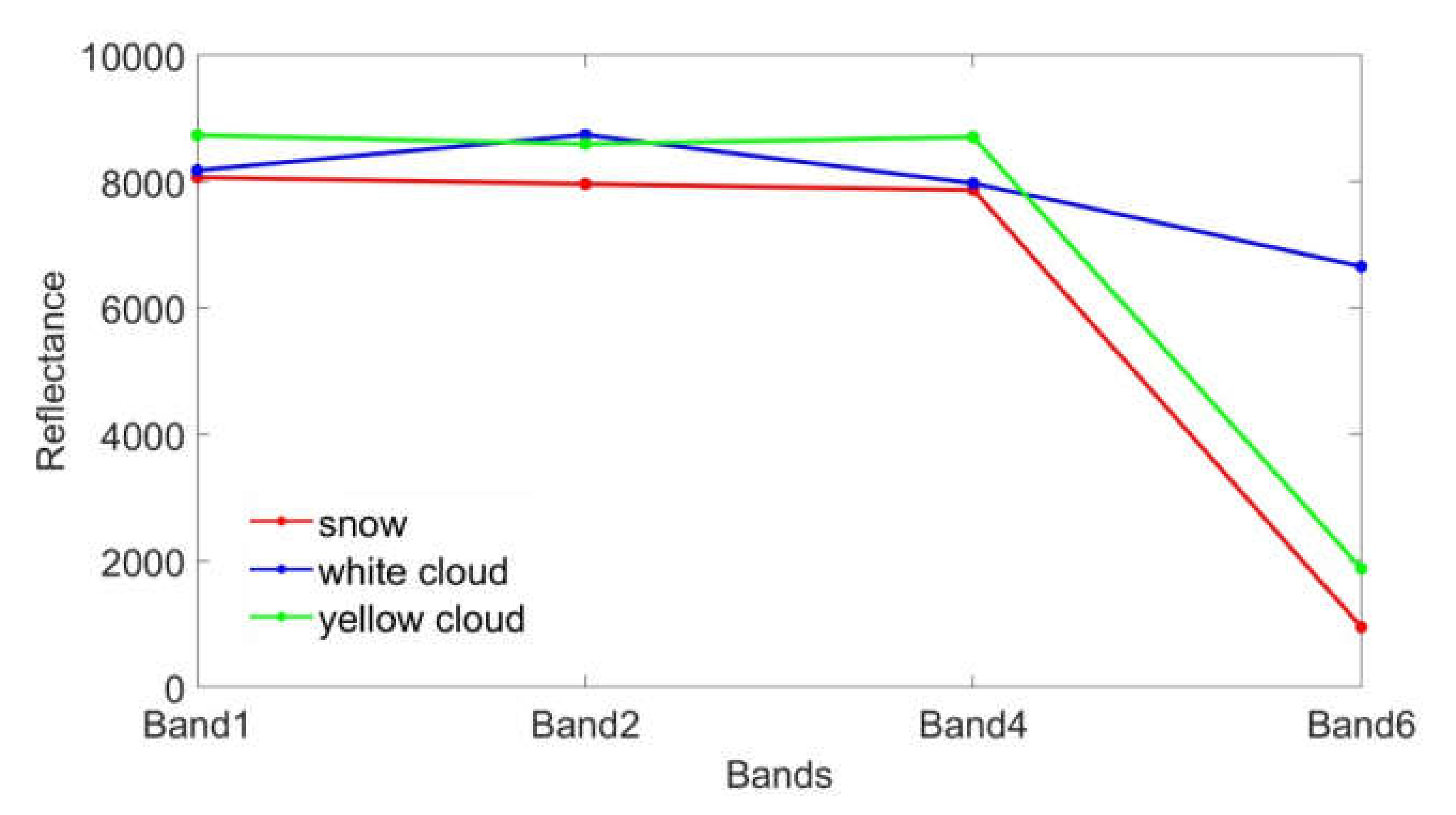
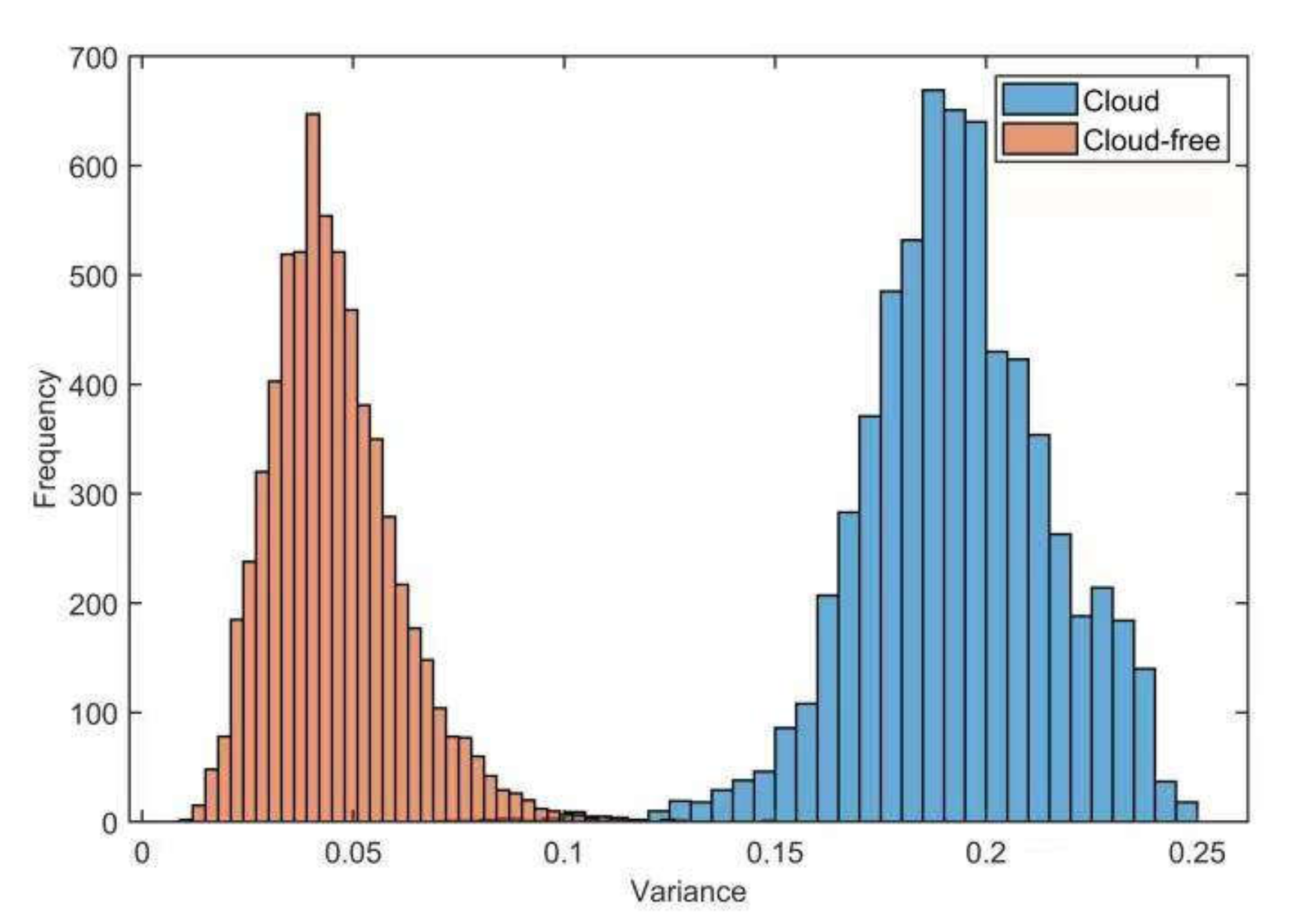
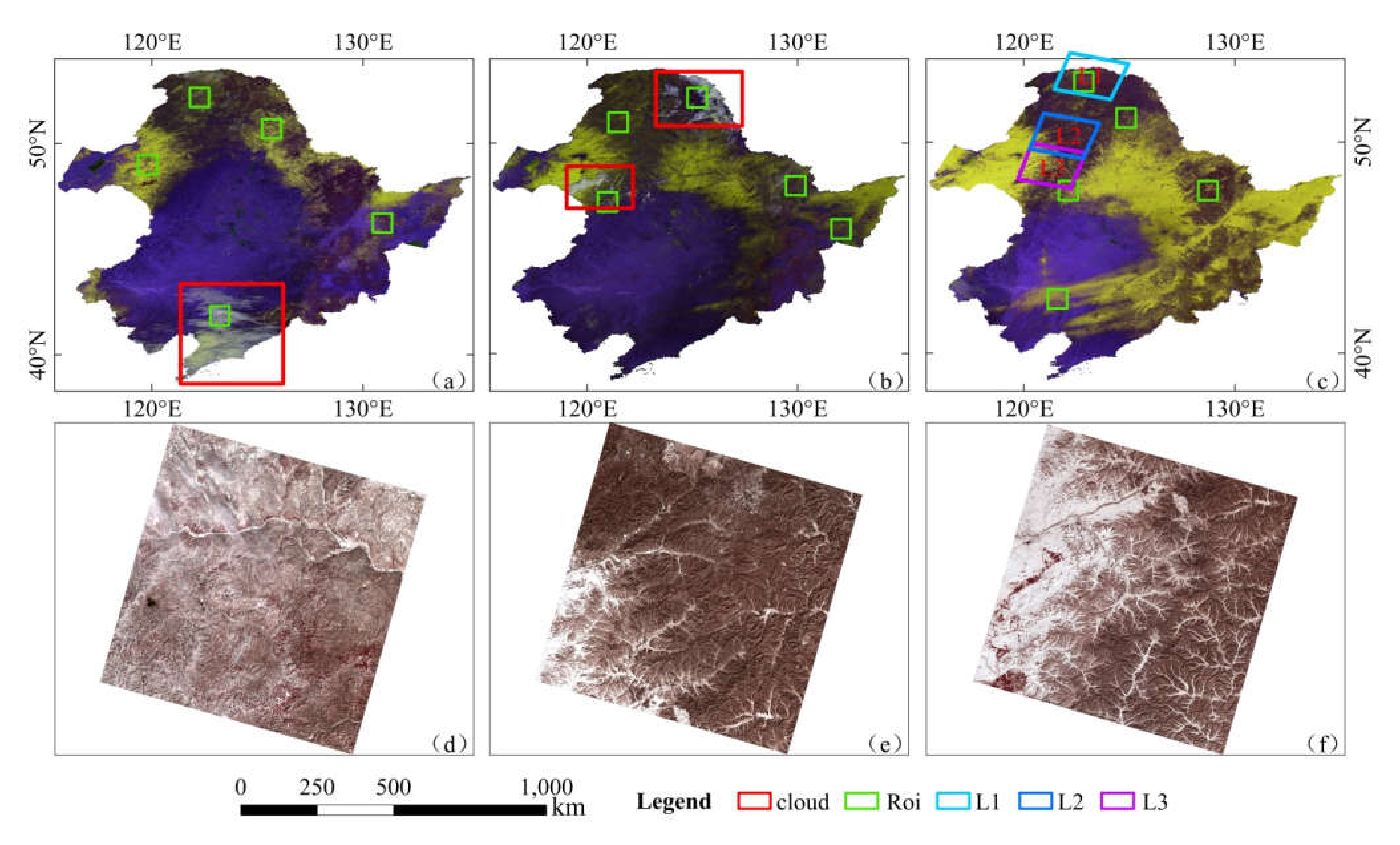
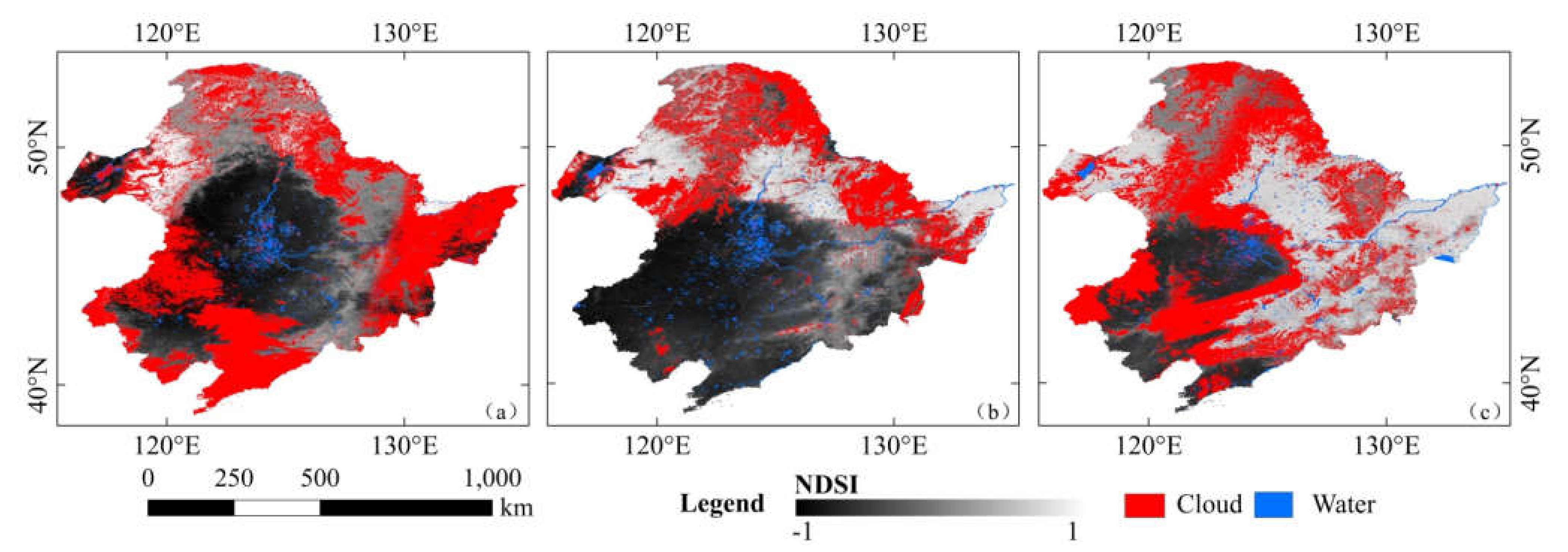
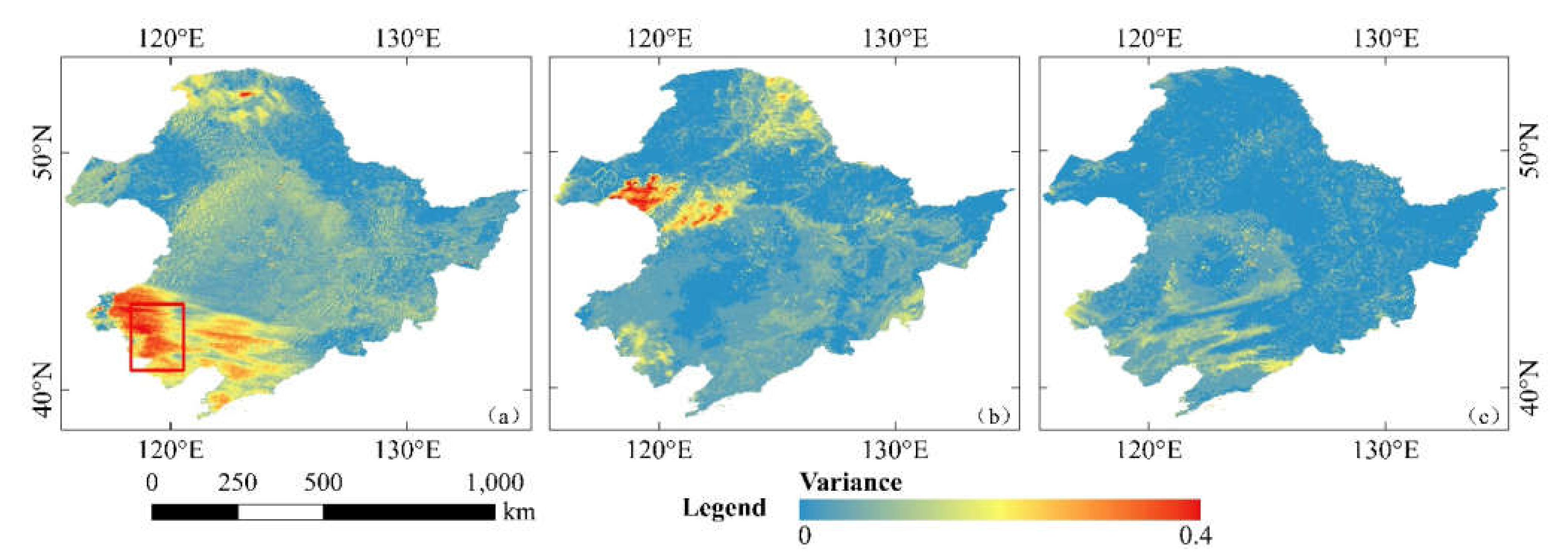
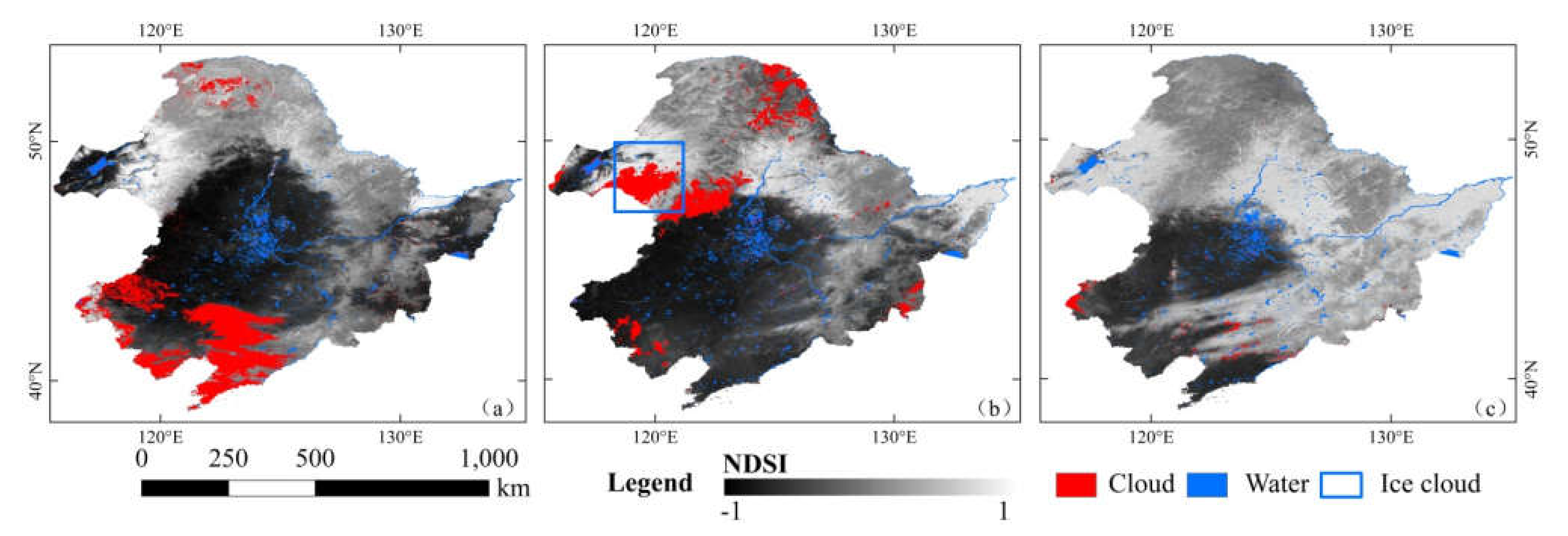
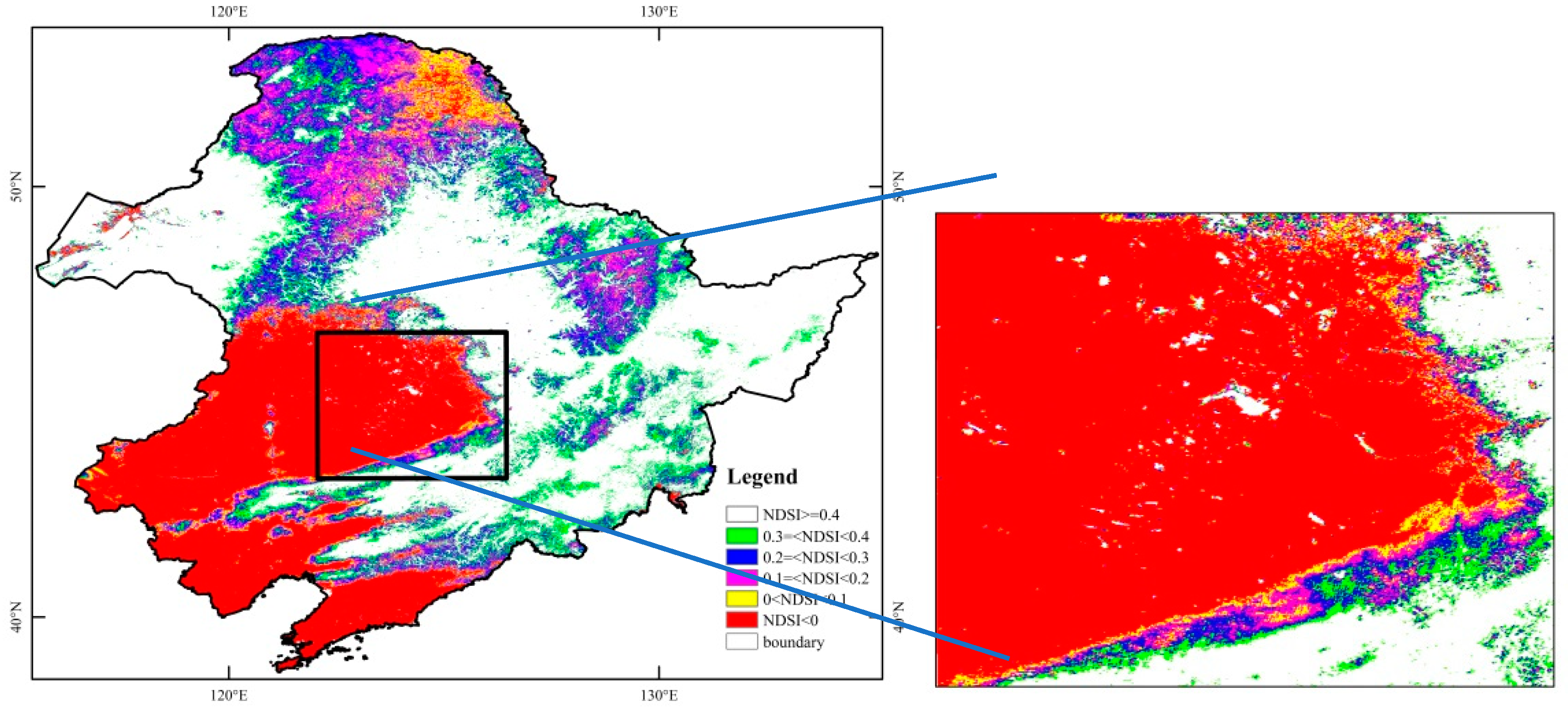
| Codes | Descriptions | Codes | Descriptions |
|---|---|---|---|
| 0–100 | NDSI-snow | 239 | Ocean |
| 200 | Missing data | 250 | Cloud |
| 201 | No decision | 254 | Detector saturated data |
| 211 | Night | 255 | Fill data |
| 237 | Inland water |
| Band | Wavelength (um) | Resolution (m) |
|---|---|---|
| 1 | 0.620–0.670 | 250 |
| 2 | 0.841–0.8761 | 250 |
| 3 | 0.459–0.479 | 500 |
| 4 | 0.545–0.565 | 500 |
| 5 | 1.230–1.250 | 500 |
| 6 | 1.628–1.652 | 500 |
| 7 | 2.105–2.155 | 500 |
| Band | Central Wavelength (um) | Resolution (km) | Band | Central Wavelength (um) | Resolution (km) |
|---|---|---|---|---|---|
| 1 | 0.47 | 1 | 9 | 6.9 | 2 |
| 2 | 0.51 | 1 | 10 | 7.3 | 2 |
| 3 | 0.64 | 1 | 11 | 8.6 | 2 |
| 4 | 0.86 | 1 | 12 | 9.6 | 2 |
| 5 | 1.6 | 2 | 13 | 10.4 | 2 |
| 6 | 2.3 | 2 | 14 | 11.2 | 2 |
| 7 | 3.9 | 2 | 15 | 12.4 | 2 |
| 8 | 6.2 | 2 | 16 | 13.3 | 2 |
| Results of Our Method | |||||||
|---|---|---|---|---|---|---|---|
| 12 February 2019 | 22 March 2018 | 16 March 2018 | |||||
| cloud | snow | cloud | snow | cloud | snow | ||
| Ground truth | cloud | 40,799 | 3521 | 21191 | 1456 | 1115 | 232 |
| snow | 3483 | 152,197 | 2619 | 174,734 | 149 | 198,504 | |
Publisher’s Note: MDPI stays neutral with regard to jurisdictional claims in published maps and institutional affiliations. |
© 2022 by the authors. Licensee MDPI, Basel, Switzerland. This article is an open access article distributed under the terms and conditions of the Creative Commons Attribution (CC BY) license (https://creativecommons.org/licenses/by/4.0/).
Share and Cite
Wang, X.; Han, C.; Ouyang, Z.; Chen, S.; Guo, H.; Wang, J.; Hao, X. Cloud–Snow Confusion with MODIS Snow Products in Boreal Forest Regions. Remote Sens. 2022, 14, 1372. https://doi.org/10.3390/rs14061372
Wang X, Han C, Ouyang Z, Chen S, Guo H, Wang J, Hao X. Cloud–Snow Confusion with MODIS Snow Products in Boreal Forest Regions. Remote Sensing. 2022; 14(6):1372. https://doi.org/10.3390/rs14061372
Chicago/Turabian StyleWang, Xiaoyan, Chao Han, Zhiqi Ouyang, Siyong Chen, Hui Guo, Jian Wang, and Xiaohua Hao. 2022. "Cloud–Snow Confusion with MODIS Snow Products in Boreal Forest Regions" Remote Sensing 14, no. 6: 1372. https://doi.org/10.3390/rs14061372
APA StyleWang, X., Han, C., Ouyang, Z., Chen, S., Guo, H., Wang, J., & Hao, X. (2022). Cloud–Snow Confusion with MODIS Snow Products in Boreal Forest Regions. Remote Sensing, 14(6), 1372. https://doi.org/10.3390/rs14061372








